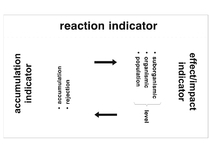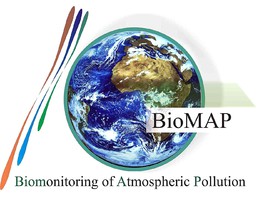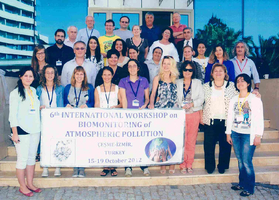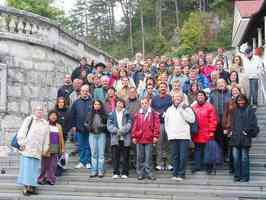
Bioindicators & Biomonitors
Definitions
In the following we will give some definitions summarized in Markert et al. (1997, 2003ff), Markert (2008):
A bioindicator is an organism (or part of an organism or a community of organisms) that contain information on the quality of the environment (or a part of the environment).
A biomonitor, on the other hand, is an organism (or part of an organism or a community of organisms) that contains information on the quantitative aspects of the quality of the environment.
The clear differentiation between bioindication and biomonitoring using the qualitative/ quantitative approach makes it comparable to instrumental measuring systems. Such effects (information bits) of bioindicators (biomonitors) may include changes in their morphological, histological or cellular structure, their metabolic-biochemical processes (including accumulation rates), their behaviour or their population structure.
Accumulation indicators/monitors are organisms that accumulate one or more elements and/or compounds from their environment. Effect or impact indicators/monitors are organisms that demonstrate specific or unspecific effects in response to exposure to a certain element or compound or a number of substances.
According to the paths by which organisms take up elements or compounds various mechanisms contribute to overall accumulation (bioaccumulation), depending on the species-related interactions between the indicators / monitors and their biotic and abiotic environment.
Biomagnification is the term used for absorption of the substances from nutrients via the epithelia of the intestines. It is therefore limited to heterotrophic organisms and is the most significant contamination pathway for many land animals except in the case of metals that form highly volatile compounds (e.g. Hg, As) and are taken up through the respiratory organs (e.g. trachea, lungs).
Bioconcentration means the direct uptake of the substances concerned from the surrounding media, f.e. the physical environment, through tissues or organs (including the respiratory organs). Besides plants, that can only take up substances in this way (mainly through roots or leaves), bioconcentration plays a major role in aquatic animals. The same may also apply to soil invertebrates with a low degree of solarisation when they come into contact with the water in the soil.
Active bioindication (biomonitoring) is meaned when bioindicators (biomonitors) bred in laboratories are exposed in a standardised form in the field for a defined period of time. At the end of this exposure time the reactions provoked are recorded or the xenobiotics taken up by the organism are analyzed. In the case of passive bioindication (biomonitoring) organisms already occurring naturally in the ecosystem are examined for their actions. This classification of organisms (or communities of these) in according to their “origin”.
Various newer methods (biomarkers, biosensors, biotests in general) have been introduced into the application field of bioindication, besides the classical floristic, faunal and biocoenotic investigations that primarily record unspecific reactions to pollutant exposure at higher organismical levels of bioindication.
Biomarkers are measurable biological parameters at the suborganismic (genetic, enzymatic, physiological, morphological) level in which structural or functional changes indicate environmental influences in general and the action of particular in qualitative and sometimes also in quantitative terms. Examples are enzyme or substrate induction of cytochrome P-450 and other Phase I enzymes by various halogenated hydrocarbons; the incidence of forms of industrial melanism as markers for air pollution; tanning of the human skin caused by UV radiation; changes in the morphological, histological or ultrastructure of organisms or monitor organs (e.g. liver, thymus, testicles) following exposure to pollutants.
A biosensor is a measuring device that produces a signal in proportion to the concentration to a defined group of substances through a suitable combination of a selective biological system, e.g. enzyme, antibody, membrane, organelle, cell or tissue, and a physical transmission device (e.g. potentiometric or amperometric electrode, optical or optoelectronic receiver).
Biomarkers and Biosensors can be used as biotest (bioassay) which describes a routine toxicological-pharmacological procedure for testing the effects of agents (environmental chemicals, pharmaceuticals) on organisms, usually in the laboratory but occasionally in the field under standardized conditions (with respect to biotic and abiotic factors). In the broader sense the definition covers cell and tissue cultures when used for testing purposes, enzyme tests or tests using microorganisms, plants and animals in the form of single-species or multi-species procedures in model ecological systems (e.g. microcosms and mesocosms). In the narrower sense, the term only covers single-species and model system tests, while the other procedures may be called suborganismic tests. Bioassays use certain biomarkers or – less often – specific biosensors and can be used in bioindication or biomonitoring.
The term tolerance can be described as desired resistance of an organism or community by unfavourable abiotic (climate, radiation, pollution) or biotic factors (parasites, pathogens), where adaptive physiological changes (e.g. enzyme induction, immune response) can be observed (Oehlmann & Markert 1997). Unlike tolerance, resistance is a genetically derived ability to withstand stress (Oehlmann & Markert 1997). This means that all tolerant organisms are resistant, but not all resistant organisms are tolerant. Sensitivity of an organism or community means its suspectibility to biotic or abiotic changes. Sensitivity is low if the tolerance or resistance to an environmental stressor is high, and sensitivity is high if the tolerance or resistance is low.
Cited references
Bargagli R, ed. (1998) Trace elements in terrestrial plants – an ecophysiological approach to biomonitoring and biorecovery. Springer, Heidelberg.
Djingova R, Kuleff I. 2000. Instrumental techniques for trace analysis. In: Markert B, Friese K. eds. Trace elements / Their distribution and effects in the environment. Elsevier, Amsterdam, 137-185.
Djingova R, Kovacheva P, Wagner G, Markert B. 2003. Distribution of platinum group elements among different plants along some highways in Germany. The Science of the Total Environment, 308, 235-246.
Fent K (2003) Ökotoxikologie. Umweltchemie, Toxikologie, Ökologie. Thieme Publisher, Stuttgart.
Figueiredo AM, Saiki M, Ticianelli R, Domingos M, Alves E, Markert B (2001) Determination of trace elements in Tillandsia usneoides by neutron activation analysis for environmental biomonitoring. Journal of Radioanalytical and Nuclear Chemistry, Vol 249, No. 2, 391-395.
Figueiredo A, Nogueira C, Markert B, Heidenreich H, Fränzle S, Liepelt G, Saiki M, Domingos M, Milian F, Herpin U (2007) The use of an epiphyte (Tillandsia usneoides L.) as bioindicator of heavy metal pollution in São Paulo, Brazil. In: Morrison G, Rauch S (eds): Highway and Urban Environment. Proceedings of the 8th Highway and Urban Environment Symposium. Springer, pp. 249-257.
Fomin A, Oehlmann J, Markert B (2003) Praktikum zur Ökotoxikologie. Grundlagen und Anwendungen biologischer Testverfahren. Ecomed / Wiley-VCH, Weinheim.
Fraenzle O (1999) Ökotoxikologie im Spannungsfeld von Ökologie und Toxikologie. In: Oehlmann J, Markert B, eds. Ökotoxikolgie. Ökosystemare Ansätze und Methoden. Ecomed-Verlagsgesellschaft, 23-48.
Fraenzle O. 2003. Bioindicators and environmental stress assessment. In: Markert BA, Breure AM, Zechmeister HG. ed. Bioindicators and biomonitors. Elsevier, Amsterdam, 41-84.
Fraenzle S, Markert B, Wünschmann S (2007) Dynamics of trace metals in organisms and ecosystems: Prediction of metal bioconcentration in different organisms and estimation of exposure risks. Environmental Pollution 150, 1, 23-33.
Fraenzle S, Uchlier L, Silbernagel H, Liepelt G (2010) Environmental heterogeneous catalysis and water purification by activated interfaces. Environm Chem Engin (Poland) 17, 26-35.
Fraenzle S, Markert B, Wünschmann S (2012) Introduction to Environmental Engineering. Wiley-VCH, Weinheim.
Freitas MC, Reis MA, Alves LC, Wolterbeek HT (2000) Nuclear analytical techniques in atmospheric trace element studies in Portugal. In: Markert B, Friese K. eds. Trace elements / Their distribution and effects in the environment. Elsevier, Amsterdam, 187-213.
Garty J (2000) Environment and elemental content of lichens. In: Markert B, Friese K. eds. Trace elements / Their distribution and effects in the environment. Elsevier, Amsterdam, 245-276.
Herpin U, Berlekamp J, Markert B, Wolterbeek B, Grodzinska K, Siewers U, Lieth H, Weckert V (1996) The distribution of heavy metals in a transect of the three states the Netherlands, Germany and Poland, determined with the aid of moss monitoring. The Science of the Total Environment, 187, 185-198.
Herpin U, Siewers U, Kreimes K, Markert B (2001) Biomonitoring – evaluation and assessment of heavy metal concentrations from two German moss surveys. In: Burga CA, Kratochvil A. General and applied aspects on regional and global scales. Kluwer Academic Publisher, Dordrecht, 73-95
Herpin U, Siewers U, Markert B, Rosolen V, Breulmann G, Bernoux M (2004) Second German heavy-metal survey by means of mosses, and comparision of the first and second approach in Germany and other European countries. Environ Si & Pollut Res, 11 (1) 57-66.
Markert B (ed.) (1993) Plants as Biomonitors. Indicators of heavy Metals in the Terrestrial Environment. VCH, Weinheim.
Markert B (2008) Bioindication and biomonitoring as innovative biotechniques for controlling trace metal influences to the environment, in: Prasad M.N.V. Trace Elements: Nutritional Benefits, Environmental Contaminatin, and Health Implications. John Wiley & Sons, 743-760.
Markert B, Oehlmann J, Roth M (1997) Biomonitoring von Schwermetallen - eine kritische Bestandsaufnahme. Zeitschrift für Ökologie und Naturschutz 6, 1-8.
Markert B, Breure A, Zechmeister H, (eds.) (2003a) Bioindicators & Biomonitors. Principles, Concepts and Applications. Elsevier, Amsterdam.
Markert B, Breure A, Zechmeister H (2003b) General aspects and integrative approaches. In: Markert B, Breure A, Zechmeister H (eds.) Bioindicators & Biomonitors. Principles, Concepts & Applications. Elsevier, 3-39.
Markert B, Fraenzle S, Fomin A (2004) From the biological system of elements to biomonitoring. In: Merian E, Anke M, Ihnat M, Stoeppler M. Elements and their compounds in the environment. Vol. 1, General aspects, Wiley, VCH, Weinheim, 235-254.
Markert B, Wünschmann S, Fraenzle S, Wappelhorst O, Weckert V, Breulmann G, Djingova R, Herpin U, Lieth, H, Schröder W, Siewers U, Steiness E, Wolterbeek B, Zechmeister H ( 2008) On the road from environmental biomonitoring to human health aspects: monitoring atmospheric heavy metal deposition by epiphytic/epigeic plants: Present status and future needs. International J. Environmental Pollution, Vol. 32, No. 4, 486-498.
Markert B, Wuenschmann S, Fraenzle S, Figueiredo A, Ribeiro A, Wang M (2011) Bioindication of trace metals - with special reference to megacities. Environmental Pollution, 159, 1991-1995.
Mueller P (1980) Biogeography. Ulmer, Stuttgart.
Oehlmann J, Markert B (Hrsg.) (1999) Ökotoxikologie. Ökosystemare Ansätze und Methoden. Ecomed / Wiley-VCH, Weinheim.
Pignata Ml, Gudino GL, Wannaz ED, Pla RR, Gonzales CM, Carreras HA, Orellana L (2002) Atmospheric quality and distribution of heavy metals in Argentina employing Tillandsia capillaris as a biomonitor. Environmental Pollution 120, 59-68.
Ribeiro AP, Figueiredo AMG, Sarkis JES, Hortellani MA, Markert B (2012) Pt, Pd and Rh Levels in soils of São Paulo City, Brazil: Assessment of automobile catalytic converter pollution. EMAS, DOI 10.1007/s10661-011-2506-8.
Ruehling A, Tyler G (1968) An ecological approach to the lead problem, 121, 321-342.
Schüürmann G, Markert B, eds. (1998) Ecotoxicology. Ecological Fundamentals, Chemical Exposure, and Biological Effects. Wiley New York, Chichester, Weinheim, Brisbane, Singapore, Toronto and Spektrum Heidelberg, Berlin.
Smodis B (2003) IAEA approaches to assessment of chemical elements in atmosphere. In: Markert B, Breure AM, Zechmeister HG. eds. 2003. Bioindicators and Biomonitors, Principles, concepts and applications, Elsevier, Amsterdam, New York, Tokyo, 875-902.
Whyte JJ, Jung RE, Schmitt CJ, Tillitt DE (2000) Ethoxyresorufin-O-deethylase (EROD) activityin fish as a biomarker of chemical exposure. Critical Reviews in Toxicology 30, 347-57.
Wolterbeek HT (2002) Biomonitoring of trace element air pollution: Principles, possibilities and perspectives, Environmental Pollution, 120, 11-21.
Wuenschmann S, Fraenzle S, Markert B, Zechmeister H (2008) Input and transfer of trace metals from food via mothermilk to the child – bioindicative aspects to human health, in: Prasad M.N.V. Trace Elements: Nutritional Benefits, Environmental Contamination, and Health Implications, John Wiley & Sons, 555-92.
Zechmeister HG (1995) Correlation between altitude and heavy metal deposition in the Alps. Environmental Pollution, 89, 73-80.
Zechmeister HG, Grodzinska K, Szarek-Lukaszewska (2003) Bryophytes. In: Markert B, Breure AM, Zechmeister HG. eds. 2003. Bioindicators and Biomonitors, Principles, concepts and applications, Elsevier, Amsterdam, New York, Tokyo, 329-375.





